Wild aurochs-like cattle reintroduced in Czech Republic (Update)
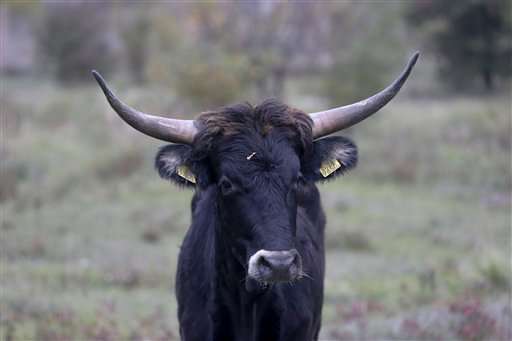
Such an animal has not been seen on Czech territory for hundreds of years.
A Dutch breeding program has recreated massive bovines closely related to aurochs, once the heaviest European land mammal and the wild ancestor of today's cattle that became extinct in the 17th century.
It is believed they disappeared from what is now the Czech Republic in the 12th or 13th century.
On Tuesday, a small herd was introduced to a Czech sanctuary as part of a project to use big-hoofed animals to maintain the steppe character of the former Milovice military base, 35 kilometers (22 miles) northeast of Prague.
The beasts joined a herd of 15 wild horses from Britain's Exmoor National Park that were moved here in January with a task to stop the spread of aggressive and evasive grasses and bushes, delicacies to the animals.
The invasive plants began to grow after Soviet troops withdrew from the base in 1991, threatening the area's original plants and animals.
After a nine-hour drive and few more minutes of hesitation, five cows and a bull—all calves— jumped out of a truck at dawn to take the first look at their new home.
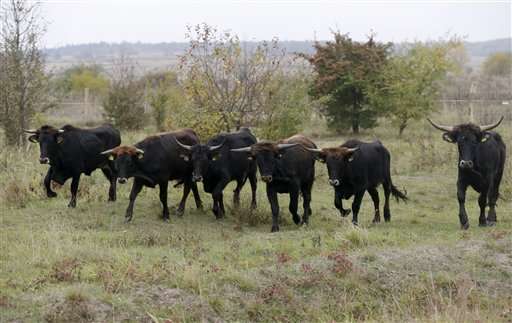
"They complement each other," said Dalibor Dostal, director of European Wildlife, the organization behind the project. He expects no conflicts between horses and cattle sharing the 40-hectare (99-acre) area.
"While the wild horses prefer grasses, the aurochs like the bushes. They don't compete. Their combination forms a natural partnership such as it was in the wild nature for thousands years."
The Dutch Taurus Foundation joined forces with the University of Wageningen and some other groups in the Tauros program, as the new animal is called, in 2008.
With knowledge of the aurochs' DNA, the scientists analyzed some existing primitive cattle breeds that are similar to their extinct ancestors. They included Pajuna, Sayaguesa and Limia from Spain, Maremmana from Italy and Highlander from Scotland.
Through cross-breeding, they have been working on reconstructing the original aurochs with the goal to have "the presence of the Tauros as a self-sufficient wild bovine grazer in herds of at least 150 animals each in several rewilding areas in Europe," Rewilding Europe, another organization involved, said on its Web site.
"In a few generations, we should be able to get an animal that looks like the aurochs and also has the same impact on the environment," Dostal said.
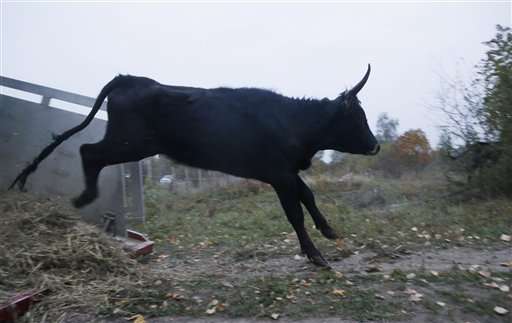
The Czech Republic is the first country in Central and Eastern Europe to receive the animals from the Netherlands, with Romania to follow. There are already herds in Portugal, Spain and Croatia.
An aurochs bull could be about 180 centimeters (nearly six feet) tall, weigh a metric ton and have long, thick horns. The adult bulls turn from chestnut color to almost black with a typical white stripe along the spine; the cows are smaller and reddish-brown.
Aurochs roamed most of the European continent as well in Northern Africa and Asia for several hundred thousand years. Their pictures appeared in a cave painting in France's Lascaux and entered the Greek mythology about founding Europe as Zeus kidnapped and seduced Europa in the form of an aurochs.
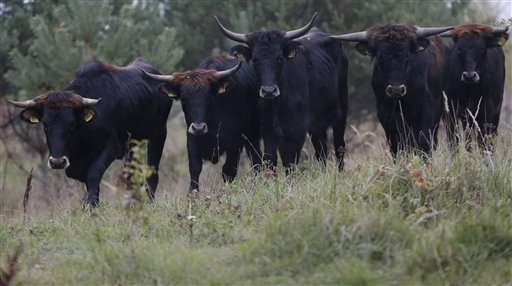
Frans Jacobs, Dutch cattle rancher who raised the animals and transported them to the Czech Republic, said he believed they will avoid the fate of the aurochs, whose last individual is said to have died in 1627 in Poland.
"They are supposed to be very strong cattle they eat whatever they can get," Jacobs said. "They will survive. They will survive us."
-
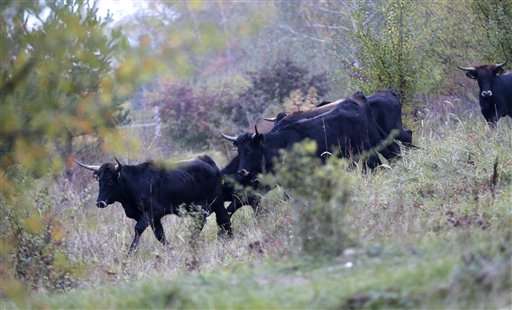
A small herd of Tauros, cattle that thanks to a Dutch breeding program is close to the ancient Aurochs, that once were the heaviest European land mammals, walk inside an enclosure at the former military base in Milovice, Czech Republic, Tuesday, Oct. 13, 2015. A small herd of Tauros was introduced to a Czech sanctuary Tuesday to join wild horses and help them improve local biodiversity. (AP Photo/Petr David Josek) -

A Tauros, a cattle that thanks to a Dutch breeding program is close to the ancient Aurochs, that once were the heaviest European land mammals, walks inside an enclosure at the former military base in Milovice, Czech Republic, Tuesday, Oct. 13, 2015. A small herd of Tauros was introduced to a Czech sanctuary Tuesday to join wild horses and help them improve local biodiversity. (AP Photo/Petr David Josek)
© 2015 The Associated Press. All rights reserved.




















